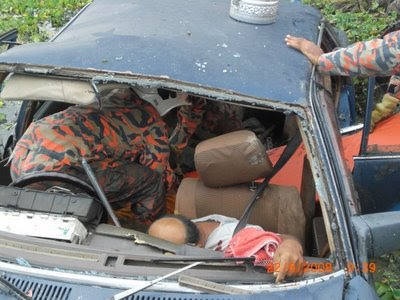
Berikut adalah antara tips-tips yang diyakini mampu menjimatkan petrol:
Elakkan menekan minyak dengan kuat, tambahkan kelajuan secara perlahan-lahan
Berbanding menambahkan kelajuan secara perlahan-lahan, menekan minyak dengan kuat akan menyebabkan penggunaan petrol bertambah sebanyak 2 hingga 3 kali ganda. Tabiat pemandu yang kasar, contohnya menekan minyak dengan kuat atau tiba-tiba menekan brek, boleh menyebabkan penggunaan petrol bertambah sebanyak 30%. Jadi, pandulah dengan cermat untuk memastikan perjalanan yang lebih lancar dan menyenangkan sepanjang hari.
Kebanyakan kereta pada masa sekarang tidak lagi menggunakan karburetor, jadi enjin kereta tidak perlu dipanaskan sebelum berjalan. Tarikkan injap sambil membawa kereta dapat memanaskan enjin secara perlahan-lahan. Pandulah kereta dengan kelajuan yang biasa sambil memanaskan kereta anda. Selepas 1 – 2 km, enjin kereta anda akan mencapai suhu yang sesuai.
Apabila pam minyak berhenti secara automatik, bermakna tangki minyak telah penuh dan harus alihkan muncung bagi mengelakkan lebihan pengisian. Keadaan ini samalah seperti anda dipaksa makan bila perut sudah kenyang. Minyak berlebihan akan menumpah keluar jika kereta anda berjalan di atas jalan raya yang tidak rata. Keadaan ini bukan sahaja membazirkan, malah tidak mesra alam.
Kekalkan jarak yang selamat dan elakkan menekan brek secara mengejut
Kelajuan kereta akan berkurangan atau berhenti jika brek ditekan, jadi enjin perlukan petrol yang lebih untuk menggerakkan semula kereta daripada gear rendah atau daripada keadaan statik.
Semasa di lebuh raya, anda barangkali akan menambahkan kelajuan tanpa disedari sambil menikmati keseronokan memecut yang tak terpada. Memecut bukan sahaja akan meningkatkan penggunaan petrol, malah juga akan meningkatkan risiko ditimpa kemalangan jalan raya.
Ramai yang suka pasangkan bendera kecil atau aksesori dan kelengkapan lain pada bumbung kereta. Benda-benda seperti itu sebenarnya merupakan perintang yang akan membebankan kereta anda dan memperlambatkan kelajuan kereta anda, seterusnya menambahkan penggunaan petrol.
Asyik merehatkan kaki kanan anda pada brek dan menekan brek bukan sahaja menambahkan penggunaan perol, bahkan juga akan memendekkan hayat brek kereta. Keadaan ini juga akan membahayakan pemandu yang mengikut di belakang kereta anda.
Tayar lebar dan rendah lebih stabil tetapi lebih tinggi penggunaan petrol
Sesetengah pemandu suka menukar tayar lebar dan rendah yang lebih luas permukaannya demi menikmati pemanduan yang lebih stabil semasa memecut. Oleh kerana permukaan tayar yang bersentuhan dengan jalan adalah lebih luas dan menyebabkan geseran yang lebih kuat, jadi ia perlukan kuasa enjin yang lebih. Keadaan ini akan meningkatkan penggunaan petrol, khususnya bermula daripada keadaan statik.
Pengetahuan Am
Elakkan daripada meletakkan kereta di tempat tidak berteduh. Suhu dalam kereta akan naik jika kereta terdedah di bawah bahangan matahari dalam tempoh masa yang panjang. Apabila kereta dibawa, sistem penghawa dingin mengambil masa yang lebih panjang untuk menyejukkan keadaan dalam kereta, akibatnya penggunaan petrol turut bertambah.
Penyenggaraan adalah wajar bagi setiap 5,000 atau 10,000 km, untuk memeriksa penapis minyak, bendalir, angin, bateri, penyambung CV dan sebagainya bagi membolehkan kereta anda berkeadaan optimum dan lebih menjimatkan petrol. Tekanan tayar juga mesti diperiksa supaya berkeadaan normal. Tekanan angin yang sesuai dapat menambahkan 3.3% jarak yang dijalani. Kekurangan tekanan tayar menghabiskan petrol yang banyak iaitu penggunaan petrol akan bertambah 0.4 sen bagi setiap pengurangan 1 paun tekanan angin. Lebih teruk lagi tayar mungkin akan pancit kerana terlampau panas. Jadi pemeriksaan tekanan tayar dengan kerap bukan sahaja menjimatkan wang, malah juga dapat melindungi keselamatan anda.. Tayar akan menggoncang jika tekanan tayar terlampau tinggi, ia juga akan mengakibatkan pancit dan membahayakan.
Karbon mungkin terkumpul pada bahagian enjin dan di sekeliling plag pencucuh jika kereta anda selalu terperangkap dalam kesesakan lalu lintas. Penimbunan karbon ini akan melemahkan proses pembakaran dan menghabiskan petrol yang lebih banyak. Jadi, plag pencucuh yang bersih boleh membantu pembakaran yang sempurna dan menjimatkan petrol.
Tenaga elektrik dalam kereta dihasilkan oleh generator. Semua alat elektrik dalam kereta seperti penghawa dingin, lampu, sistem penggera, stroboskop dan sebagainya, hanya akan membebankan generator. Semakin banyak tenaga elektrik diperlukan, generator perlu mengeluarkan tekanan yang lebih pada timing belt untuk menghasilkan lebih banyak tenaga elektrik. Keadaan ini sudah pasti akan menambahkan penggunaan petrol.
Ramai pemandu jarang mengemaskan dan membersihkan benda-benda yang tertimbun dalam keretanya, kadang-kala mencapai 40-50kg! Lebihan berat ini bersamaan dengan membawa lebih seorang penumpang, penggunaan petrol juga akan bertambah 1-2%.
Sesetengah kedai pengubahsuaian kenderaan akan menasihatkan pemilik kereta supaya menukarkan konverter katalisator. Pada halnya, pengubahsuaian sebegini hanya akan menekan ekzos lalu membebaskan lebih banyak tenaga dan menghabiskan petrol yang lebih.












